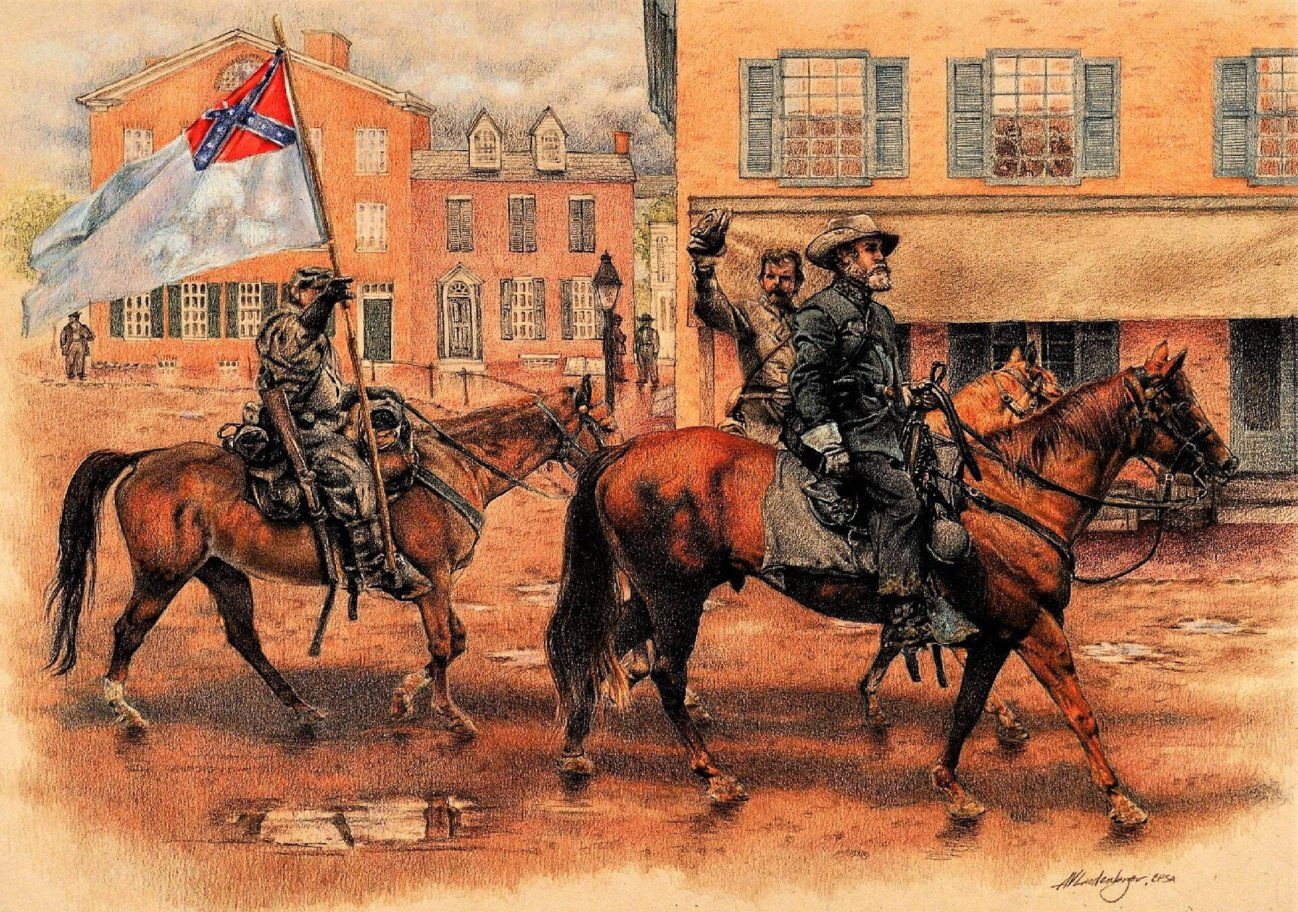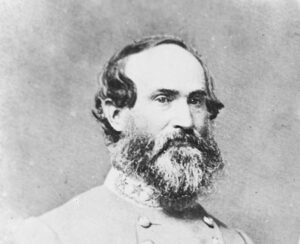
The Confederate Conquest of Gettysburg – How The Town Was Taken
February 28, 2024Southern Victory and the Conquest of Gettysburg
The Invasion Begins
After his success at Chancellorsville, Virginia in May 1863, General Robert E Lee led his army through the Shenandoah Valley to begin his second invasion of the North—what would later be known as the Gettysburg Campaign. Lee wanted to move the focus of the summer campaign away from beleaguered northern Virginia, and to strike a blow against Union morale by penetrating as far north as Harrisburg.
There were few obstacles in his way and even fewer ready defenders to block the incursion. Pennsylvania had contributed a great many men to the war, but now that their own state was invaded, they could do nothing. The man who could, Army of the Potomac commander Joseph Hooker, was detained for the time being in Frederick, Maryland, where he advised the evacuation of Harpers Ferry. Pennsylvania Governor Andrew Curtin ordered the raising of 60,000 state militia to repel the invasion themselves, but that futile gesture would take too long to stop the encroaching rebels.
The invasion was on, with Confederate General Jubal Early leading the pack.
The Conquerer of Gettysburg

Jubal Anderson Early graduated from the United States Military Academy in 1837 and spent his early military career fighting Seminole Native Americans in Florida, but later resigned to become a successful lawyer. He served in the Virginia House of Delegates before being reinstated to serve in the Mexican War as a Major of Virginia volunteers.
Prior to the Civil War, he was passionately opposed to secession and even voted against it, but once the war began, he accepted orders as Colonel of the 24th Virginia Infantry. Following his infantry’s performance at First Manassas, Early was promoted to Brigadier General, and was present at most major battles in the Eastern Theater, with the Seven Days Battles, Second Bull Run, Antietam, Fredericksburg, and Chancellorsville among them. He was promoted to Major General in January of 1863 and would go on to serve with distinction in both the Salem Church and Gettysburg campaigns.
Circumstances contrived to make Early late to Pickett’s Charge, but in truth, he was EARLY to Gettysburg and even successfully conquered it… if a few days too soon.
War Comes to Gettysburg
The first shots fired “at Gettysburg” actually occurred on June 26, 1863, over a week before the beginning of the famous three-day battle.
Confederate expeditionary forces advanced toward the town of Gettysburg, driving Union forces and local militia out of town and sending them packing. After destroying the ironworks of famed abolitionist Thaddeus Stevens out of spite, the invading Confederates advanced along Chambersburg Pike (modern-day Rt 30) into the Gettysburg area.
Gettysburg wasn’t Early’s actual destination. His troops were actually on their way to York, Pennsylvania, to seize the famous mile-long covered bridge spanning the Susquehanna River. But Early and other commanders had established a pattern of moving into a town and making demands on the town council for money and supplies. It was a way not only of potentially securing provisions for their troops, but of instilling uneasiness into the local population at the same time.
As his force of men neared the town, 4 local bushwhackers fired on Early’s marching forces. One of them, Henry Hahn, shot and killed one of the marching troops. Unsure of the size and strength of the attacking force, Early split his forces down the Chambersburg pike and down Hilltown Road to Mummasburg Rd to approach Gettysburg from two directions.
He was met by the 26th Pennsylvania Emergency Infantry, mustered into Federal service just a few days earlier, led by William Jennings, accompanied by a squadron of cavalry under the command of Robert Bell. These 748 troops (made up mostly of college students from nearby Gettysburg College) were no match for Early’s force of skilled veterans.
After a brief skirmish, they broke ranks and ran, fleeing 4 miles north to Bailey’s Hill, where they were again confronted, this time by Jubal Early himself and his personal complement of troops. After another brief skirmish, they were routed, and most of the would-be defenders were taken prisoner.
The first Confederates to arrive in Gettysburg were an advance squadron of cavalry who swept into town in a fearsome, chaotic manner, terrorizing the local inhabitants. An additional infantry brigade arrived a bit later, but the town would not be formally conquered until Early’s own division arrived shortly thereafter.
Early’s Arrival and the Conquest of Gettysburg
On the morning of June 26, 1863, Confederate General Jubal Early and his troops, acting as the vanguard of the Army of Northern Virginia’s invasion of Pennsylvania, marched into the town of Gettysburg, Pennsylvania, for the first time, easily conquering it and seizing it for the Confederacy.
What might technically be classified as the first Union casualty “at Gettysburg” occurred when a paid substitute soldier, George Sando of Bell’s Cavalry, raised his pistol at the Confederates and was shot dead.
At about 4 p.m., Early—who had sent advance word to the borough council that he wanted to meet with them to “make a requisition”—personally rode to the town center, seeking the civic authorities of Gettysburg to parley.
Upon learning that most of the town government had fled town in advance of their arrival, Early was directed to speak to David Kendlehart, president of the town council. Early demanded a monetary ransom from the town lest he release his men to destroy it. Kendalhart responded with a counteroffer to open the shops and stores of the town, allowing the Confederates to take whatever they wished as requisitioned supplies. Early agreed he would spare the town under these terms, but in the end, the Confederate commander received little of what he was demanding; most available supplies had already been moved to safer locations away from town.
The Confederate conquest of Gettysburg was brief. Even so, Gettysburg resident Sarah Broadhead later relayed her frustration at the situation: “The Rebel band were playing Southern tunes in the Diamond. I cannot tell how bad I felt to hear them and to see the traitor’s flag flying overhead.”
Sallie Myers, another resident, reported, “We were not afraid, but it is exasperating that we are now under the control of armed traitors.”
Early’s men camped in town overnight. The following morning, the General and his company departed for adjacent York County. Before departing the town, the exiting Confederate burned several railroad cars and a local bridge, destroying nearby rail lines and telegraph lines and creating havoc as they went.
Unfortunately for Early, his overnight delay in Gettysburg slowed his progress long enough for hastily recruited Union defenders to burn the famous covered bridge at Wright’s Ferry, which was Early’s main objective. Shortly thereafter, Early and his force were called back again to the area of Gettysburg, where forces were now gathering for the famous battle that would ultimately influence the outcome of the rest of the war.
Visit Gettysburg in Person
Plan your next excursion with us! Our bus tours of the historic Gettysburg Battlefield are active and ready to show you the sites of the historical battleground. Reservations can be made by calling our toll-free number at 877-680-8687. You can also purchase bus tour tickets online. Tours depart from the Gettysburg Tour Center located at 777 Baltimore St., Suite 100.